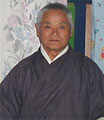 |
Bhutan Economy |
|
 |
Bhutan Information |
|
|
 |
|
A
master craftsman's story
|
 |
| Sitting
by the window of his comfortable home in Thimphu, 70-year-old Namgay
Tshering spends his time praying, reading scriptures and religious
biographies. But he is not one of those pampered old men wallowing in the
care and hospitality of his children in his twilight years. He is a master
craftsman enjoying his days of retirement. In a 50-year career as a troelko
(gold and silver smith), Namgay Tshering has taught and trained scores
of smiths and has left behind a rich legacy of his own skills. "Not really
to boast, I can safely say that I have done a bit for my country," Namgay
Tshering told. |
|
And
the "bit" that he had done includes the construction of the 17 feet pelphug
chorten in Taktshang, the 15 feet machen chorten in Punakha, the Druk Wangyel
medal (the country's highest national award), and the two kilkhors (mandalas)
in the Thimphu and the Punakha dratshangs.It also includes three swords
and a bathra for His Late Majesty, hundreds of souvenirs for state guests,
and countless other gold and silver artifacts, ornaments and wares for
the royal household.
He
had cast and constructed over 25 bronze, silver and gold chortens and made
the kudung chortens for the previous Namkhai Nyingpo and Khamtrul Rinpoche.
His works can be found not only in many major lhakhangs in Bhutan but also
in Nepal and India. Of all the work that he has done in his lifetime, he
is "most honoured" by the machen chorten in Punakha dzong which houses
the embalmed body of the Zhabdrung.
Namgay
Tshering was the engineer, designer and supervising craftsman of the machen
chorten which took some 30 men six years to complete. Another work that
"brings pride and joy" in his heart is the Druk Wangyel medal. He designed
and made the Druk Wangyel - the highest national award instituted by His
Majesty the King - in a record 20 days.
The
Druk Wangyel was posthumously awarded to the late prime minister of India,
Indira Gandhi, by His Majesty the king in 1985. Namgay Tshering was born
into a family of troelkos in Drawanglo in Paro where a troelzo tradition
existed since the Zhabdrung's time. His maternal uncle served in the court
of the first king. His own father, who was a renowned troelko, worked for
the second king. He learnt the art and craft of troelzo from his father
at the age of 10. Namgay Tshering said that learning troelzo is a difficult
and demanding job.
A
learner or trainee begins by carving human forms, birds and animals, all
the saints and renowned masters in the Buddhist pantheon, and all religious
signs and symbols in their most intricate detail. "It takes a great deal
of patience, skill and endurance," he said. "Very few people can master
the troelzo in its entirety. Out of 60 people who begin learning at the
same time, may be only about three will become a good troelko. "His greatest
regret today is that the craft to which he dedicated his life, skill, and
love is declining. He feels that troelkos these days are commercially driven
and are more concerned with outer appearance than with doing a genuinely
good job."
Everybody
wants to have an easy time and make good money," he said adding that for
the craft to succeed whoever takes it up "must be genuinely interested,
devoted to the profession and determined to excel". He also feels that
special recognition and incentives need to be given to those who are exceptionally
talented and good." Zorig chusum (13 arts and crafts) must not be allowed
to disappear," he said. "All the dzongs, lhakhangs, chortens and in fact
our unique cultural and religious identity owe its existence and origin
to zorig chusum. What we are able to show to the outside world as distinctly
Bhutanese is essentially because of zorig chusum."That is why although
he is retired, he continues to teach. He has taught about ten boys since
retiring in 1998. Two boys are presently training under him. "I am doing
my best to impart whatever I know to those who are interested to learn,"
said Namgay Tshering, the teacher of about 70 troelkos.
Namgay
Tshering has seen his country evolve from wilderness into a modern nation
state in a lifetime spanning three kings. He said that the Bhutan of today
is like a dream compared to the one he knew as a young man. Pem, his partner
in life, love and struggle for over 50 years and mother of his eight children
said she could not describe how hard, difficult and cruel life was in those
days. "There was a heaven and earth's difference between gom (authority)
and yop (subordinates)," Namgay Tshering told.
|
"Everyone
is so equal today I feel like there is no gom."
|
| This
article was contributed by KUENSEL, Bhutan's National Newspaper 2004 |
 |
|
more
information
|

|
|

